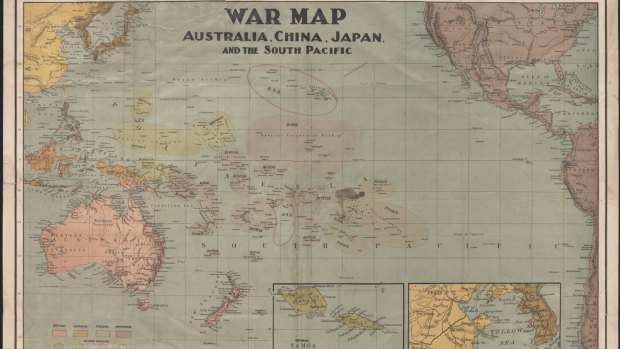By Denis Shephard
Mapping the Great War
One of my jobs as a member of the curatorial team developing the National Library's Keepsakes: Australians and the Great War exhibition was to select a small representative sample of maps from the library's extensive – in terms of numbers and coverage – collection of World War I maps. Having developed a deep interest in 19th- and 20th-century surveying and mapping through my work as a draftsman then museum curator, I found this both a challenging and a rewarding task. With so many to choose from, which would be most relevant to the themes of Keepsakes?

World War I map: Australia, China, Japan and the South Pacific.
The library's map collection numbers in the hundreds of thousands, among which are hundreds relating to the Great War. These include operational maps, propaganda maps, officially produced maps, commercially produced maps and maps prepared after the war to accompany official and commemorative histories. Complementing the maps are many air photographs.
The maps have been collected as individual items; as part of collections assembled by individuals such as George Alan Vasey and Ernest Keith White as mementoes of their war experiences; and, by private military map collectors, such as Cyril Sydney Hertz. Others can be found in manuscript collections, including those of Great War veterans Sir John Monash and Arthur Wesley Wheen. Many have been accessible in digital format on the library's website for some time whilst some have only recently been digitised. Many more are only available in hard copy format.
To select from this diverse range was a challenge, albeit an enjoyable one. In the end, 12 maps were chosen, of which seven are looked at here.
The two operational maps – The Battles in Flanders (1917) and Target Map (June 1, 1917) – detail the "probable" location of artillery targets, the disposition of enemy troops and any other obstacles likely to affect any troop advance. An essential part of all battle planning, this class of map was prepared before all major actions and were compiled using traditional land survey methods, sound ranging, flash spotting and aerial reconnaissance.
The War Map, Australia, China, Japan and the South Pacific shows the Asian and Pacific Theatre of the First World War whilst the Robur War Map, showing the Dardanelles Theatre, is an example of a commercially produced "follow-the war" map available to the general public. It came with a set of 175 flags to mark changing battle fronts. The Second Military District and South Australian Recruitment were officially produced maps detailing military organisation within Australia. Humoristische Karte von Europa im Jahre 1914 is a German political caricature map based on popular stereotypes of the type that had been published by various European states for many years. England, for example, is shown dragging Japan into the war while standing on bags of money and being punched in the face by the iron fist of Germany.
Four air photographs, taken during the final stages of the Palestine campaign between June and September 1918, have also been included, to illustrate the importance of aircraft to the Allied war effort. In the air, combat was only incidental to reconnaissance work (including photography), support for artillery and strategic bombing. Single air photographs provided information about ground activities over a small area or, when joined together to create a mosaic, over larger areas. When viewed through a stereoscope in overlapping pairs they provided a three-dimensional view of small areas. By end of war, about 6 million air photos had been printed for the Allies on the Western Front alone.
Taken as a whole, the National Library's Great War map collection provides both an overview and a detailed study of the war as it happened. The individual maps chosen for Keepsakes illustrate a small part of that diverse story.
Denis Shephard was a member of the curatorial team that developed Keepsakes. He volunteers in the map room at the National Library of Australia
Keepsakes: Australians and the Great War is showing at the National Library of Australia until July 19.